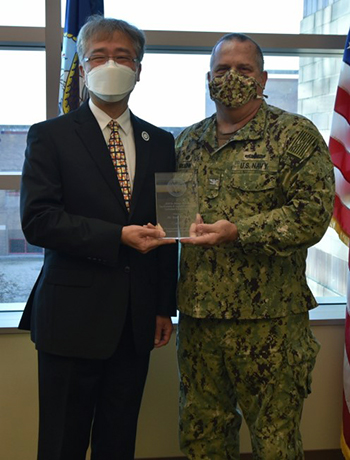 Dr. Yoon Hwang, a scientist with Naval Medical Research Unit San Antonio receives the DOD’s Dr. Delores Etter Award for Scientist of the Year in 2020 from Navy Capt. Andrew Vaughn, NAMRU-SA’s commanding officer, Dec. 18, 2020, in the Battlefield Health and Trauma Building at Joint Base San Antonio-Fort Sam Houston, Texas. Hwang participated in the San Antonio Postdoctoral Research Forum in December and described military career opportunities to postdoctoral research fellows in attendance. (Photo by Randy Martin.)
Dr. Yoon Hwang, a scientist with Naval Medical Research Unit San Antonio receives the DOD’s Dr. Delores Etter Award for Scientist of the Year in 2020 from Navy Capt. Andrew Vaughn, NAMRU-SA’s commanding officer, Dec. 18, 2020, in the Battlefield Health and Trauma Building at Joint Base San Antonio-Fort Sam Houston, Texas. Hwang participated in the San Antonio Postdoctoral Research Forum in December and described military career opportunities to postdoctoral research fellows in attendance. (Photo by Randy Martin.)
Dozens of NAMRU-SA’s scientists, engineers, and support staff adapted for the new format.
Smith stated that during the convention three scientists presented posters on topics including: the application of phage display to develop a molecular probe for snake venom identification, improving envenomation outcomes by inhibiting systemic distribution factors, and physical, chemical, and biological comparison of clinically available products for their use in alveolar ridge preservation.
For all participants, this year’s SAPRF was unique.
In the computer-generated format, attendees transited the virtual convention space as an avatar. Each could pause and view any of the more than 85 posters, the tools that scientists routinely use to present, describe, and promote their work. A hundred preselected judges provided feedback and projects were ranked within contributing institutions to give an element of competition. According to Smith, the number of entries broke previous participation records.
Among the judges were several of NAMRU-SA’s senior scientists.
“We were able to review the posters ahead of time to familiarize ourselves with the material and prepare to pose questions to presenters via a chat program,” said Dr. Ashley Dacy, a biomedical engineer in NAMRU-SA’s Biomedical Systems Engineering and Evaluation Department. “The additional time meant I could offer even more meaningful feedback than in a live presentation.”
Other NAMRU-SA staff members served as panelists for question and answer sessions focused on topics affecting careers in science.
“SAPRF was a good opportunity to let the science community in San Antonio know the excellent scientific research that goes on in NAMRU-SA, said Dr. Yoon Hwang, a Department of Defense scientist of the year award winner and member of NAMRU-SA’s Maxillofacial Injury and Disease Department.
“It’s also good for the potential collaboration with universities or biotech companies and recruiting highly qualified postdoctoral fellows and research scientists,” Hwang said.
The format for 2021’s SAPRF isn’t set but NAMRU-SA is already planning to expand its role.
NAMRU-SA's mission is to conduct gap driven combat casualty care, craniofacial, and directed energy research to improve survival, operational readiness, and safety of Department of Defense personnel engaged in routine and expeditionary operations. For more information about NMRU-SA visit their webpage.